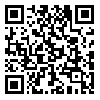Volume 25 - Special Issue
jrehab 2024, 25 - Special Issue: 682-701 |
Back to browse issues page
Download citation:
BibTeX | RIS | EndNote | Medlars | ProCite | Reference Manager | RefWorks
Send citation to:



BibTeX | RIS | EndNote | Medlars | ProCite | Reference Manager | RefWorks
Send citation to:
Soleimani F, Babaiy Z, Vahedi M, Nobakht Z, Shirinbayan P, Ghorbanpour Z et al . Determining Item Sequence of Bayley Scale in Persian Language Children. jrehab 2024; 25 (S3) :682-701
URL: http://rehabilitationj.uswr.ac.ir/article-1-3418-en.html
URL: http://rehabilitationj.uswr.ac.ir/article-1-3418-en.html
Farin Soleimani1 

 , Zahra Babaiy2
, Zahra Babaiy2 

 , Mohsen Vahedi1
, Mohsen Vahedi1 

 , Zahra Nobakht1
, Zahra Nobakht1 

 , Peymaneh Shirinbayan1
, Peymaneh Shirinbayan1 

 , Zahra Ghorbanpour1
, Zahra Ghorbanpour1 
 , Fatemeh Hassanati *3
, Fatemeh Hassanati *3 




 , Zahra Babaiy2
, Zahra Babaiy2 

 , Mohsen Vahedi1
, Mohsen Vahedi1 

 , Zahra Nobakht1
, Zahra Nobakht1 

 , Peymaneh Shirinbayan1
, Peymaneh Shirinbayan1 

 , Zahra Ghorbanpour1
, Zahra Ghorbanpour1 
 , Fatemeh Hassanati *3
, Fatemeh Hassanati *3 


1- Pediatric Neurorehabilitation Research Center, University of Social Welfare and Rehabilitation Sciences, Tehran, Iran.
2- Department of Speech Therapy, Faculty of Rehabilitation Sciences, University of Social Welfare & Rehabilitation Sciences.Tehran, Iran.
3- Pediatric Neurorehabilitation Research Center, University of Social Welfare and Rehabilitation Sciences, Tehran, Iran. ,fatemehhasanati64@gmail.com
2- Department of Speech Therapy, Faculty of Rehabilitation Sciences, University of Social Welfare & Rehabilitation Sciences.Tehran, Iran.
3- Pediatric Neurorehabilitation Research Center, University of Social Welfare and Rehabilitation Sciences, Tehran, Iran. ,
Abstract: (4179 Views)
Objective The Bayley scale is one of the important and well-known tests to measure the development in the early life of children. Using this test, it is possible to identify possible developmental delays and the child's strengths and weaknesses. In the previous studies, cultural adaptation and standardization were performed in the Persian language. However, it is necessary to examine the item sequence in each language and culture. This study investigates the appropriateness of the Bayley sequence in the Persian language children.
Materials & Methods This was a secondary study and the data from previous standardization studies were used. The scores of 1-42 month old children in each age group were analyzed for each item. As the difficulty of the items increased during the test, if deviated from the process, it indicated that the item was not in its proper position. In this study, by examining the difference in scores before and after each item, deviant items were identified.
Results The results showed that 41 items deviated from the main trend, of which 27 deviated items were at the starting point. Among the 27 deviant items at the starting point, 14 items were easier than the previous items (item 42=cognitive, items 10, 20, 24=receptive communication, items 3, 5, 10, 15, 18=expressive communication, items 24 and 39=fine motor, and items 20, 53, and 55=gross motor).
Conclusion According to the results, there are 14 deviant items in the Bayley scale for the Persian language, which may have an impact on the test result, which is a small amount compared to the total test items. Nevertheless, it is recommended to examine these items in the next revisions of the test so that a correct estimate of the development process of Persian-speaking children can be made.
Materials & Methods This was a secondary study and the data from previous standardization studies were used. The scores of 1-42 month old children in each age group were analyzed for each item. As the difficulty of the items increased during the test, if deviated from the process, it indicated that the item was not in its proper position. In this study, by examining the difference in scores before and after each item, deviant items were identified.
Results The results showed that 41 items deviated from the main trend, of which 27 deviated items were at the starting point. Among the 27 deviant items at the starting point, 14 items were easier than the previous items (item 42=cognitive, items 10, 20, 24=receptive communication, items 3, 5, 10, 15, 18=expressive communication, items 24 and 39=fine motor, and items 20, 53, and 55=gross motor).
Conclusion According to the results, there are 14 deviant items in the Bayley scale for the Persian language, which may have an impact on the test result, which is a small amount compared to the total test items. Nevertheless, it is recommended to examine these items in the next revisions of the test so that a correct estimate of the development process of Persian-speaking children can be made.
Type of Study: Original |
Subject:
Pediatric Neurology
Received: 25/12/2023 | Accepted: 22/07/2024 | Published: 1/11/2024
Received: 25/12/2023 | Accepted: 22/07/2024 | Published: 1/11/2024
Send email to the article author
| Rights and permissions | |
 |
This work is licensed under a Creative Commons Attribution-NonCommercial 4.0 International License. |





